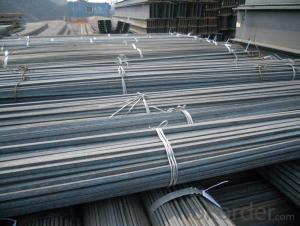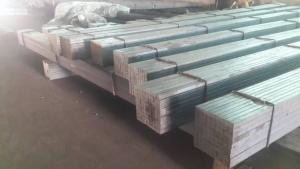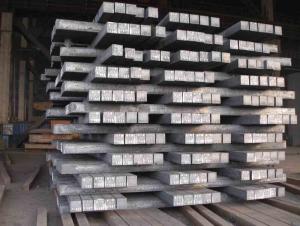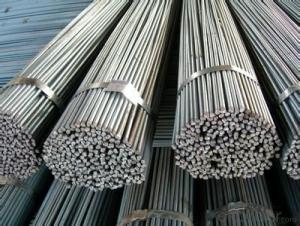Hot Rolled Square Steel Bar Material Q235
- Loading Port:
- Qingdao
- Payment Terms:
- TT or LC
- Min Order Qty:
- 25 m.t.
- Supply Capability:
- 3000 m.t./month
OKorder Service Pledge
OKorder Financial Service
You Might Also Like
Product Description:
OKorder is offering Hot Rolled Square Steel Bar at great prices with worldwide shipping. Our supplier is a world-class manufacturer of steel, with our products utilized the world over. OKorder annually supplies products to European, North American and Asian markets. We provide quotations within 24 hours of receiving an inquiry and guarantee competitive prices.
Product Applications:
The Square Steel is normally used as structure steel.
Row material for other structure steel like steel angles, channels, I-beams, H-beams, etc…
Product Advantages:
OKorder's Hot Rolled Square Steel Bar Material Q235 are durable, strong, and resist corrosion.
Main Product Features:
· Premium quality
· Prompt delivery & seaworthy packing (30 days after receiving deposit)
· Corrosion resistance
· Can be recycled and reused
· Mill test certification
· Professional Service
· Competitive pricing
Product Specifications:
Length of a side(mm) | Theoretical weight(kg/m) | Length of a side(mm) | Theoretical weight(kg/m) |
6 | 0.283 | 32 | 8.04 |
7 | 0.385 | 33 | 8.55 |
8 | 0.502 | 34 | 9.07 |
9 | 0.636 | 35 | 9.62 |
10 | 0.785 | 36 | 10.17 |
11 | 0.950 | 38 | 11.24 |
12 | 1.13 | 40 | 12.56 |
13 | 1.33 | 42 | 13.85 |
14 | 1.54 | 45 | 15.90 |
15 | 1.77 | 48 | 18.09 |
16 | 2.01 | 50 | 19.63 |
17 | 2.27 | 53 | 22.05 |
18 | 2.54 | 55 | 23.6 |
19 | 2.82 | 56 | 24.61 |
20 | 3.14 | 58 | 26.4 |
21 | 3.46 | 60 | 28.26 |
22 | 3.80 | 63 | 31.16 |
23 | 4.15 | 65 | 33.17 |
24 | 4.52 | 68 | 36.3 |
25 | 4.91 | 70 | 38.49 |
26 | 5.30 | 75 | 44.16 |
27 | 5.72 | 80 | 50.24 |
28 | 6.15 | 85 | 56.72 |
29 | 6.60 | 90 | 63.59 |
30 | 7.06 | 95 | 70.85 |
31 | 7.54 | 100 | 78.50 |
Notes:
1, The theoretical weights in the list, base on the density of 7.85 g/cm3.
2, The numbers with mean that they are not regulars or we don’t offer them.
-List 2. The allowed tolerance of Square Steel:
Length of a side(mm) | Allowed Tolerance | ||
Group1 | Group2 | Group3 | |
5.5~7 | ±0.20 | ±0.30 | ±0.40 |
7~20 | ±0.25 | ±0.35 | ±0.40 |
20~30 | ±0.30 | ±0.40 | ±0.50 |
30~50 | ±0.40 | ±0.50 | ±0.60 |
60~80 | ±0.60 | ±0.70 | ±0.80 |
80~110 | ±0.90 | ±1.0 | ±1.1 |
110~150 | ±1.2 | ±1.3 | ±1.1 |
150~190 | ―― | ―― | ±2.0 |
190~250 | ―― | ―― | ±2.5 |

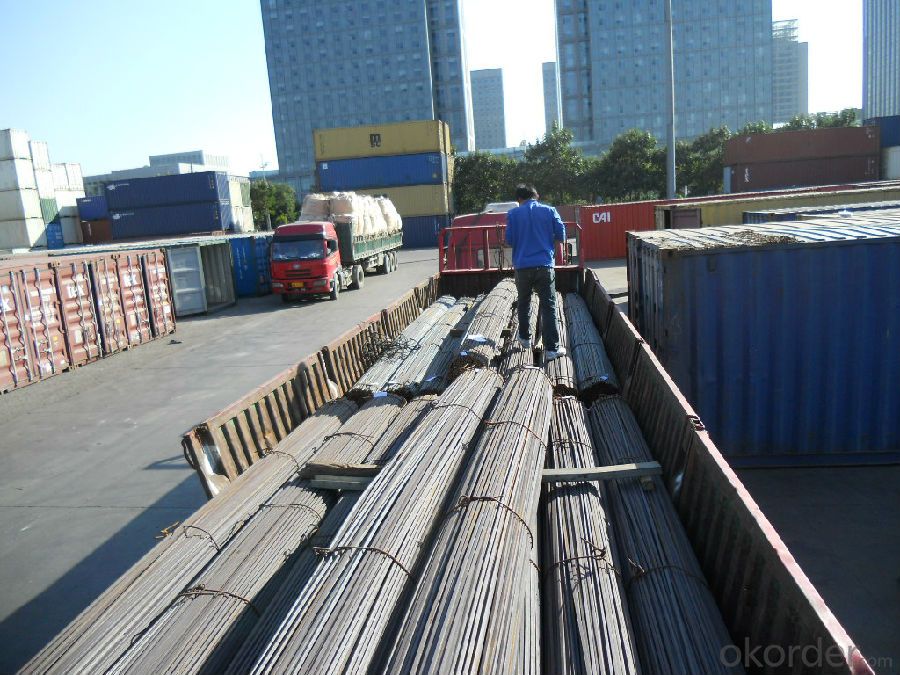
Payment:
-Invoicing on theoretical weight or actual weight as customer’s request.
-Regular terms of payment:
1, 30% payment in advance, the remaining balance (70% payment) against the copy of B/L.
2, 30% payment in advance, the remaining balance (70% L/C) against the copy of B/L.
3, Negotiable.
FAQ:
Q1: Why buy Materials & Equipment from OKorder.com?
A1: All products offered byOKorder.com are carefully selected from China's most reliable manufacturing enterprises. Through its ISO certifications, OKorder.com adheres to the highest standards and a commitment to supply chain safety and customer satisfaction.
Q2: How do we guarantee the quality of our products?
A2: We have established an advanced quality management system which conducts strict quality tests at every step, from raw materials to the final product. At the same time, we provide extensive follow-up service assurances as required.
Q3: How soon can we receive the product after purchase?
A3: Within three days of placing an order, we will begin production. The specific shipping date is dependent upon international and government factors, but is typically 7 to 10 workdays.
- Q:How do you use a steel square to find roof pitch?
- To use a steel square to find roof pitch, you will need to follow a few simple steps. First, ensure that your steel square is properly calibrated and in good condition. Next, position the square on the roof in a way that the long edge of the square is aligned with the bottom edge of the roof. Make sure the square is level and firmly in place. Once the square is in position, use a level to ensure that the square is perfectly horizontal. This will help you get accurate measurements. Now, look at the markings on the square. On one of the arms of the square, you will find a pitch scale that represents the roof pitch in inches per foot or degrees. Align the scale on the square with the bottom edge of the roof and read the corresponding pitch measurement on the scale. This measurement will indicate the steepness of the roof pitch. Remember that the measurements on the steel square are standardized, so you can easily compare them to building codes or other references to determine if the roof pitch is within acceptable limits. Using a steel square is a simple and reliable method to find the roof pitch, allowing you to accurately assess the slope of the roof and make informed decisions when it comes to repairs or construction projects.
- Q:What are the common applications of a steel square in metal fabrication?
- A steel square, also known as a framing square or a carpenter's square, is commonly used in metal fabrication for various applications. Some of the common uses include measuring and marking right angles, checking the squareness of corners and edges, laying out and marking cuts, and aligning and squaring components during fabrication. It is a versatile tool that helps ensure accuracy and precision in metalwork.
- Q:How do you use a steel square to determine angles for door casing?
- In order to determine angles for door casing using a steel square, it is necessary to follow a few straightforward steps. 1. Begin by ensuring that the steel square is clean and in good condition. The accuracy of your measurements can be affected by any dirt or damage. 2. Place the steel square against the door casing, making sure that one leg is flush with the horizontal surface and the other leg is aligned with the vertical surface. 3. Once the square is correctly positioned, mark the edge of the square on the casing using a pencil or marker. 4. Proceed to measure the angle indicated by the steel square. This can be accomplished by reading the markings on the edge of the square. While most steel squares have markings for 45-degree and 90-degree angles, some also have additional markings for other angles. 5. Once you have determined the angle, transfer the measurement to your door casing. If necessary, use a protractor or angle finder tool to ensure accuracy. 6. Lastly, use a saw or other suitable tools to cut the door casing at the marked angle. To ensure a proper fit, verify the fit by placing the cut piece against the door frame. It is essential to note that achieving precise angles for door casing using a steel square requires practice and accuracy. By taking your time, double-checking measurements, and using the appropriate tools, you will be able to achieve the best results.
- Q:How do you use a steel square to measure board diagonals?
- To use a steel square to measure board diagonals, you will need to follow a few steps. First, place the steel square on one corner of the board, ensuring that one of the arms lines up with the edge of the board. Make sure the steel square is flat against the board surface. Next, extend the arm of the steel square across the width of the board until it reaches the opposite edge. Take note of the measurement where the arm intersects the edge of the board. Then, move the steel square to the adjacent corner of the board. Align one of the arms with the same edge as before and extend it across the width of the board until it reaches the opposite edge. Again, note the measurement where the arm intersects the edge. Finally, compare the two measurements you obtained. If they are equal, it means the board is perfectly square. If they differ, it indicates that the board is not square, and the difference between the two measurements represents the amount the board deviates from being square. Using a steel square to measure board diagonals is a simple and effective method to check for squareness, which is important in various woodworking and construction projects to ensure accurate and precise results.
- Q:How does a steel square assist in determining the correct angle for a compound miter cut?
- The steel square, which is also called a combination square, proves to be a versatile tool, serving as a helpful aid in determining the correct angle for a compound miter cut. When it comes to making a compound miter cut, it becomes imperative to measure and set the angles accurately for both the miter and bevel cuts. This is precisely where the steel square comes into play. Primarily, the steel square possesses a built-in protractor, allowing for the measurement and setting of the desired angle for the miter cut. In most cases, this protractor bears degree increments, facilitating the precise setting of angles. Moreover, the steel square boasts a ruler positioned along its edge, capable of measuring the workpiece's length and guaranteeing precise cuts. To ascertain the correct angle for a compound miter cut, the typical procedure involves setting the desired miter angle using the protractor on the steel square. Once the miter angle is established, one can employ the ruler to measure the workpiece's length and mark the intended cut line. Subsequently, after completing the miter cut, one would need to modify the bevel angle to generate the compound angle. Again, the steel square can be employed to accurately measure and set the bevel angle. By utilizing the steel square's protractor and ruler, one can ensure that the miter and bevel angles are precisely determined, resulting in accurate and neat compound miter cuts. This proves crucial for achieving tight joints and proper alignment when working on projects like furniture, cabinetry, or trim work.
- Q:Can a steel square be used for fence-building projects?
- Yes, a steel square can be used for fence-building projects. A steel square, also known as a framing square or a carpenter's square, is a versatile tool that is commonly used in construction and woodworking projects. It can help ensure accurate and square cuts, angles, and measurements, which are essential for building a sturdy and well-aligned fence. Whether you are constructing a wooden fence or a metal fence, a steel square can be used to lay out the fence posts, mark the angles for cuts, and check for squareness during the installation process. It is a valuable tool for any fence builder and can greatly assist in achieving precise and professional results.
- Q:How do you use a steel square for marking stair skirt board angles?
- The process of using a steel square to mark stair skirt board angles is simple. Here is a guide on how to do it: 1. Begin by measuring the rise and run of the stairs. The rise refers to the vertical height between two stair treads, while the run is the horizontal distance between them. Take note of these measurements as they will be important for the next steps. 2. Position the steel square against the skirt board, making sure that the longer arm of the square is vertical and aligned with the edge of the board. 3. Determine the angle for the skirt board by referring to the rise and run measurements. For instance, if the rise is 7 inches and the run is 10 inches, divide the rise by the run (7/10) to obtain the decimal value of 0.7. Locate this decimal value on the rise and run tables of the steel square, which are usually found on the inner part of the square. 4. Once you have found the decimal value on the rise and run tables, locate the corresponding number on the blade of the steel square. This number represents the angle at which you should cut the skirt board. 5. Use a pencil or marking tool to make a mark on the skirt board according to the reference number on the blade of the steel square, indicating the determined angle. 6. Before proceeding with cutting or any subsequent steps, carefully check your measurements and markings to ensure accuracy. By following these steps, you can effectively utilize a steel square to mark stair skirt board angles. It is crucial to measure accurately and double-check your calculations to achieve precise and accurate results.
- Q:How do you use a steel square to determine the slope of a deck surface?
- To determine the slope of a deck surface using a steel square, you can place one side of the square on the deck surface and adjust the other side until it is level. By measuring the distance between the level side of the square and the deck surface at different points, you can determine the slope of the deck.
- Q:What are some common uses for a steel square in cabinet making?
- Some common uses for a steel square in cabinet making include measuring and marking right angles, checking for squareness or alignment of cabinet components, verifying diagonal measurements for accurate assembly, and ensuring precise cuts and joints.
- Q:How do you use a steel square to measure board lengths?
- To measure board lengths using a steel square, here are the steps you should follow: 1. Align one side of the steel square with the end of the board, placing it on the edge of the board. 2. Check if both sides of the square touch the board's edge to ensure that the square is perfectly perpendicular to the board. 3. Securely hold the square against the board to prevent any movement. 4. Examine the measurements marked on the blade of the square. Most steel squares have measurements in inches, with one side indicating length and the other indicating width. 5. Determine the length of the board by reading the measurement on the blade where the opposite end of the board aligns. 6. Record the measurement for future reference or make a mark on the board. It is crucial to emphasize the importance of accuracy when measuring board lengths with a steel square. Ensure proper alignment between the board and the square, and firmly hold the square against the board to achieve precise measurements.
1. Manufacturer Overview |
|
|---|---|
| Location | |
| Year Established | |
| Annual Output Value | |
| Main Markets | |
| Company Certifications | |
2. Manufacturer Certificates |
|
|---|---|
| a) Certification Name | |
| Range | |
| Reference | |
| Validity Period | |
3. Manufacturer Capability |
|
|---|---|
| a)Trade Capacity | |
| Nearest Port | |
| Export Percentage | |
| No.of Employees in Trade Department | |
| Language Spoken: | |
| b)Factory Information | |
| Factory Size: | |
| No. of Production Lines | |
| Contract Manufacturing | |
| Product Price Range | |
Send your message to us
Hot Rolled Square Steel Bar Material Q235
- Loading Port:
- Qingdao
- Payment Terms:
- TT or LC
- Min Order Qty:
- 25 m.t.
- Supply Capability:
- 3000 m.t./month
OKorder Service Pledge
OKorder Financial Service
Similar products
New products
Hot products
Related keywords
